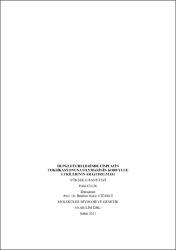| dc.contributor.advisor | Ciğerci, İbrahim Hakkı | |
| dc.contributor.author | Çelik, Sakine Hilal | |
| dc.date.accessioned | 2021-04-02T05:53:51Z | |
| dc.date.available | 2021-04-02T05:53:51Z | |
| dc.date.issued | 2021 | en_US |
| dc.identifier.uri | https://hdl.handle.net/11630/8573 | |
| dc.description.abstract | Tıbbi bitkilerin tarihi insanlık tarihi kadar eskidir. Tıbbi bitkiler terapötik ajan olarak kullanılmakla birlikte, sentetik ilaçların geliştirilmesi için de çok önemlidir. Günümüzde bitkisel tedaviye olan ilgi tüm dünyada artmıştır.
Deve dikeninden (Silybum marianum) elde edilen ve flavonoid yapısında aktif bir bitki ekstresi olan silymarin (SLM), antioksidan etkiye sahiptir. Aynı zamanda, silymarinin antiproliferatif, antiinflamatuar ve antikarsinojenik etkilere sahip olduğu başka çalışmalarda da gösterilmiştir.
Cisplatin (CP), çeşitli kanserlerin tedavisinde yaygın olarak kullanılan bir kemoterapötik ajandır. Kanser hücrelerinin gelişimini engellemektedir ve ancak sağlıklı hücreleri de yok ettiği bilinmektedir. Bitkisel bileşiklerin kemoterapötik ilaçlarla birlikte kullanılmasıyla antikanser etkisinin artırılması ve yan etkilerin azaltılması için birçok çalışma yapılmaktadır.
Bu çalışmada karaciğer karsinom hücreleri (HepG2) kullanılmıştır. HepG2 hücrelerinde SLM’nin CP toksikasyonuna etkileri MTT yöntemi (3-4,5-dimetil-tiyazolil-2,5-difeniltetrazolyum bromid), comet (tek hücre jel elektroforezi) ve mikronükleus testi yöntemi kullanılarak araştırılmıştır. Yapılan çalışmada, SLM ve CP’nin HepG2 hücrelerindeki sitotoksisitesi MTT yöntemi ile belirlenmiştir ve farklı konsantrasyonlarda hücre canlılığı etkisine bakılmıştır. Sonrasında SLM’nin CP ile kombinasyonu ile comet yöntemi ve mikronükleus testi yapılarak genotoksisite çalışmaları yapılmıştır.
SLM’nin HepG2 hücreleri üzerindeki sitotoksisitesinin belirlenmesi için kontrol grubu, 1000 - 500 - 250 - 150 ve 75 µg/mL dozları kullanıldı. Mikroplak okuyucu ile 540 nm’de okutularak bulunan değerler yüzde (%) olarak ifade edildi. SLM’nin LD0 değeri 75 µg/mL bulunmuştur. SLM’nin artan dozlarında hücre canlılığı artarken doz azaldıkça hücre canlılığı da azalmıştır. CP’nin HepG2 hücrelerinde LD50 değeri 65,6 µg/mL olarak bulunmuştur.
Gruplar; kontrol grubu, SLM (LD0) grubu, CP grubu (LD50) ve SLM+CP (LD50+LD0) grubu olacak şeklinde planlandı. 24 saatlik uygulama sonrasında genotoksisiteyi belirlemek üzere comet ve mikronükleus testleri çalışıldı.
CP’nin HepG2 hücrelerinde DNA hasarı oluşturarak toksisiteyi arttırdığı, SLM’nin LD0 dozu CP toksikasyonu sonucu oluşan genotoksisiteyi azalttığı gözlemlenmiştir. Böylece SLM’nin DNA koruyucu özellikte olduğu düşünülmektedir. | en_US |
| dc.description.abstract | The history of medicinal plants is as old as human history. Although medicinal plants are used as therapeutic agents, they are also essential for the development of synthetic drugs. Today, interest in herbal therapy has increased all over the world.
Silymarin (SLM), an active plant extract obtained from milk thistle (Silybummarianum) and having a flavonoid structure, has an antioxidant effect.At the same time, it has been shown in other studies that silymarin has antiproliferative, anti-inflammatory and anticarcinogenic effects.
Cisplatin (CP) is a chemotherapeutic agent widely used in the treatment of various cancers. It prevents the growth of cancer cells and also destroys healthy cells.Many studies are conducted to increase the anticancer effect and reduce the side effects by using herbal compounds together with chemotherapeutic drugs.
Liver carcinoma cells (HepG2) were used in this study. Effects of SLM on CP intoxication in HepG2 cells were investigated using MTT method (3-4,5-dimethyl-thiazolyl-2,5-diphenyltetrazolium bromide), comet (single cell gel electrophoresis) and micronucleus test method. In the study, cytotoxicity of SLM and CP in HepG2 cells was determined by MTT method and the cell viability effect was examined at different concentrations. Subsequently, genotoxicity studies were carried out by performing the comet method and micronucleus test with the combination of SLM with CP.
To determine the cytotoxicity of SLM on HepG2 cells, the control group, 1000 - 500 - 250 - 150 and 75 µg / mL doses were used. The values found by scanning at 540 nm with a microplate reader were expressed as percentage (%). LD0 value of SLM was found to be 75 µg / mL. While cell viability increased with increasing doses of SLM, cell viability decreased as the dose decreased. LD50 value of CP in HepG2 cells was found as 65.6 µg / mL.
Groups; The control group was planned as SLM (LD0) group, CP group (LD50) and SLM + CP (LD50 + LD0) group. Comet and micronucleus tests were studied to determine genotoxicity after 24 hours of application.
It increased genotoxicity because CP increased toxicity by causing DNA damage in HepG2 cells, LD0 dose of SLM decreased genotoxicity resulting from CP toxicity. Thus, SLM is thought to have DNA protective properties. | en_US |
| dc.language.iso | tur | en_US |
| dc.rights | info:eu-repo/semantics/openAccess | en_US |
| dc.subject | Silymarin | en_US |
| dc.subject | Cisplatin | en_US |
| dc.subject | Comet yöntemi | en_US |
| dc.subject | HepG2 hücreleri | en_US |
| dc.subject | MTT testi | en_US |
| dc.subject | Mikronükleus testi | en_US |
| dc.title | Hepg2 Hücrelerinde Cisplatin Toksikasyonuna Silymarinin Koruyucu Etkilerinin Araştırılması | en_US |
| dc.title.alternative | Investigation Of Protective Effects Of Silymarine On Cisplatin Toxication İn Hepg2 Cells | en_US |
| dc.type | masterThesis | en_US |
| dc.department | Mühendislik Fakültesi | en_US |
| dc.identifier.startpage | 1 | en_US |
| dc.identifier.endpage | 75 | en_US |
| dc.relation.publicationcategory | Tez | en_US |
| dc.contributor.institutionauthor | Çelik, Sakine Hilal | |



















